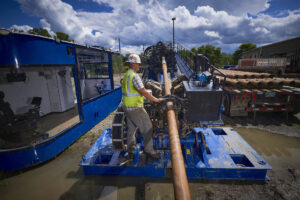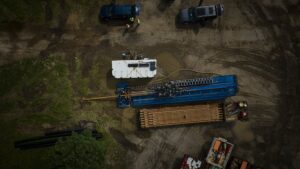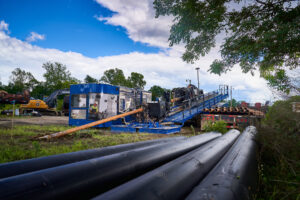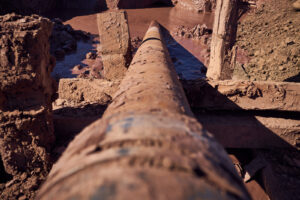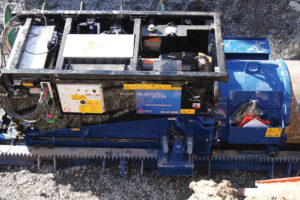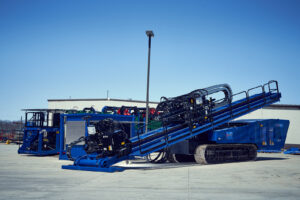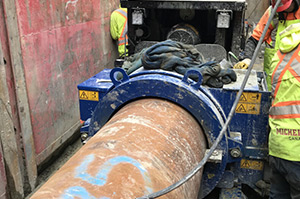By Richard Levings
As featured in Trencless Technology
3 Key Factors to Keep in Mind When Auger Boring
Underground ground professionals know that completing a project on time and within budget is the name of the game in today’s industry. And auger boring jobsites are no different.
Auger boring is one of the oldest forms of trenchless technology in the underground construction industry. It continues to be utilized today as it is a cost-effective solution when completing large-diameter bores. However, as the workforce shortage continues to plague the industry, having reliable equipment, understanding jobsite procedures, and utilizing equipment that will keep limited crews comfortable and productive become even more essential to helping contractors work safely and efficiently.
Here are three key factors contractors should consider when looking to complete an auger boring project on time and on budget.
1. Make Maintenance a Priority
Operators know that having reliable equipment is paramount to jobsite success. When maintained properly, auger boring machines can help contractors efficiently bore through tough ground conditions and promote uptime. By adhering to regular maintenance schedules and daily checks, operators can help minimize costly downtime and optimize jobsite safety – equipping contractors with the tools to finish a project on time.
Reading the operator manual can ensure contractors are up-to-date on all necessary preventative maintenance items including daily checks and recommended intervals for servicing based on time-related milestones. For example, visually inspecting the hydraulic hoses to see if they are frayed and checking electrical systems to ensure there are no broken wires are all imperative to daily, routine maintenance. Additionally, understanding which components to inspect after 10 hours vs. 500 hours of use, is also important and found in the operator manual.
Completing maintenance requirements can help reduce machine wear and tear and extend the life of the operators’ equipment. To help reduce wear and tear, contractors should check the equipment alignment of components and visually inspect the equipment before they start a bore. For example, if the alignment of the gear rack is not properly placed, then the pinion shaft – which is pressed up against the gear rack – can experience increased wear and tear. It is also important to maintain the proper alignment of the tooling when connected to the auger boring machine. Over time, the alignment of these pieces together can become warped, and the connection unstable, which can increase the risk of equipment damage.
2. Choosing Auger Boring Equipment that Meets Jobsite Regulations
All around the world, states and countries – even local municipalities – are implementing various regulations to address safety and environmental concerns related to the construction industry. From cities wanting to see lower emissions in their communities to jobsites having noise ordinances in place, jobsite requirements are continuing to influence the industry.
To ensure the bore is completed on time and within budget, it is important for contractors to understand and be prepared for jobsite specific regulations. This can include choosing which equipment to bring on-site or investing in future solutions to meet these needs.
For example, the growing environmental push to reduce emissions has encouraged manufacturers to look at powering equipment differently. Electrical equipment has started to gain traction in many parts of the world due to its zero emissions, influencing the creation of electric auger boring machines. Electric auger boring machines allow crews to do their jobs without worrying about breathing in fumes or having to step away from the jobsite for health reasons. An electric option can also save costs by reducing the need for air monitoring or circulation equipment.
Additionally, the noise level of equipment on a jobsite can often limit when a contractor can work – especially if they are working near the city. This is because many cities have noise ordinances in place that only allow crews to run their equipment during certain hours of the day. An electric auger boring machine is a quieter option allowing contractors to work longer on jobsites, with less risk of violating ordinances.
In one example, Riggtech, a Swedish contractor, needed to complete a 36-m bore as part of a storm sewer installation in the city of Gothenburg, Sweden. However, local laws required that construction crews keep noise levels down. Using an electric auger boring machine, Riggtech was able to complete the job while still meeting the city’s noise ordinances.
Keeping jobsite regulations and future requirements in mind can help contractors stay successful amid the industry’s ever-changing landscape.
3. Optimizing Operator Comfort to Boost Productivity
Underground construction professionals know that the comfort of the operator can make or break productivity. On an auger boring jobsite, operators are often exposed to hazardous fumes while working in the pit, which can limit the amount of time contractors can spend in the pit – reducing their productivity. To help improve operator comfort, manufacturers are designing equipment with the operator in mind.
Choosing equipment that keeps operators comfortable can also help to ensure an auger boring project is completed on time. For example, one of the biggest benefits of an electric auger boring machine is the ability for operators to step out of the pit and control the machine with a wireless remote. Not only will this help eliminate a contractor’s exposure to fumes, but it also gives contractors increased visibility to oversee all machine operators.
Additionally, an electric machine gives operators the freedom to adjust speed and torque according to what the job requires. On traditional machines, torque and speed are tied together and determined by the operator’s chosen gear. But an electric machine can achieve full torque instantly. This allows operators to balance torque and speed based on soil conditions, helping contractors meet a wider range of jobsite demands.
Both electric and traditional auger boring machines have their advantages, so knowing which is more comfortable for your crew to operate is a major factor in jobsite productivity.
In Summary
A well-oiled machine, well-understood jobsite and well-kept staff are all key factors to a successful jobsite. As industry standards continue to be in flux, contractors can take extra measures to extend the life of the equipment. Additionally, investing in machines that coincide with jobsite regulations, and ones that boost operator comfort, can all have a big impact on the success of a jobsite.
